Pete Jorgensen
Plant Science & Horticulture
The History and Aesthetics of Miniature Gardens
The average garden size in the UK is shrinking, and the number of UK homes with no private garden is growing. Miniature gardening can be a fun and useful way for those with a shortage of outdoor space and those with disabilities to enjoy horticultural activities. They also encourage children to partake in horticultural activities. These factors have fuelled interest in miniature gardening, with a number of enthusiastic authors releasing books on the subject, including Janit Calvito’s 2013 publication ‘Gardening in Miniature’ and Holly Farrell’s 2016 book: ‘RHS Miniature Garden Grower’. These authors build on decades of niche post-war publications by authors such as Ann Ashberry, Lawrence D. Hills and Martin Baxendale.
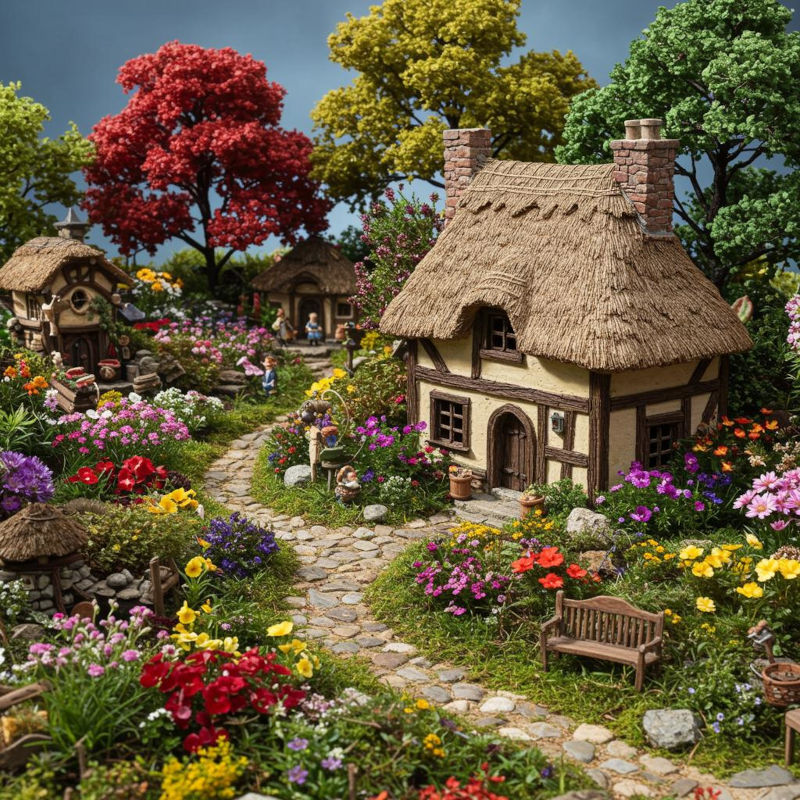
A miniature garden in the 'Ann Ashberry' style.
Miniature Gardening, Ancient History, Penjing, and Bonsai.
To the best of our (current) knowledge miniature gardening has its origins in the far east with the Chinese tradition of penjing or penzai and the better known Japanese bonsai. The meanings of penjing, penzai and bonsai are often cited as 'tray plant' or ‘tray planting’ [1] [2]. A more literal direct translation (using Google translate) from the Chinese penjing 盆 景 (taken from here) suggests that penjing actually means 'pot plant' and this translation is also supported on the Chinese dictionary website pinpinchinese.com. From this I discovered a publication by the National Bonsai and Penjing Museum in the USA [3] which refers to penjing as ‘pot plants with landscape’ although Harold E. Mahoney, president of the Bonsai society of Greater New York describes the translation of penjing as ‘tray scene’ [4].
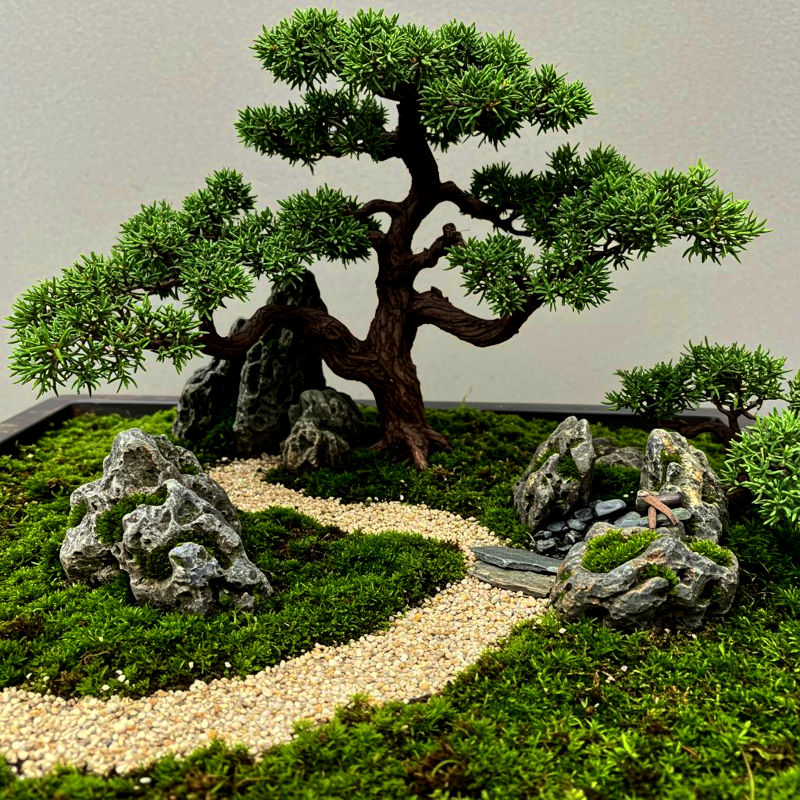
A miniature 'penjing' landscape.
Bonsai is the culture of a single miniaturized tree in a self-contained pot. Creations involving more than one specimen being referred to as, 'saikei'. Penjing is generally a broader term and often involves several plants and occasionally no trees at all the aim being to create a miniature landscape rather than a single specimen. There are, in fact, various categories of penjing including shumu penjing, the cultivation of one or more miniature trees; shanshui penjing, the creation of a miniature landscape using plants (not trees), rocks and often water; shuihan penjing, similar to shanshui penjing, but including miniature trees [5].
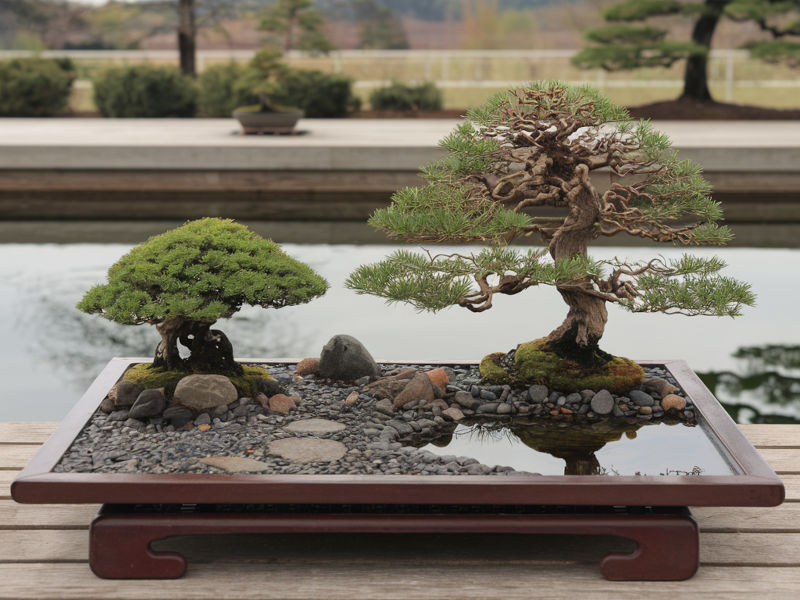
A miniature 'shuihan penjing' landscape.
Hon non bo
Hon non bo is a Vietnamese form of miniature gardening, which usually involves creation of an island landscape surrounded by water [6].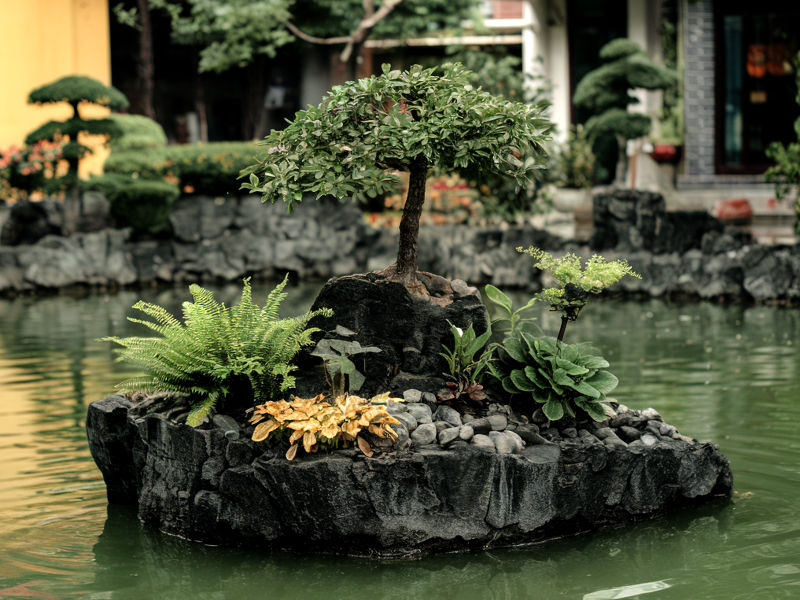
A Vietnamese-style Hon Non Bo garden.
Miniature alpine gardens
Alpine gardens can come in many sizes and do not need to be miniature gardens – there is an extensive one at Beilefeld Botanical Gardens, Mitte, Germany. Due to the adaptations that Alpine plants have made to survive in their natural habitat, they do tend to make very useful plants for small-scale gardens. Lawrence Hills wrote a book during World War II and published not long after VE day, that was specifically aimed at miniature alpine gardening. He noted that they are often planted in small stone troughs, sinks and the like and this style of garden had become more popular since domestic ornamental garden space had almost entirely been used for food production due to the war effort [7].
Fairy gardens
Faerie, faery, fairie, fairy good! There is a tale as early as 1808 about Reverend Dr Joseph Jowett of Trinity Hall, Cambridge creating “...a fairy garden, with narrow walks, enameled with shells and pellucid pebbles; and the whole enclosed with a delicate and curious kind of Chinese railing.” [8] The history of fairy gardens appears to be at least 200 years old. Shakespeare’s ‘The Tempest’ and ‘A Midsummer Night’s Dream’ are cited as being highly influential in categorizing faeries as forces of nature [9] and congruently green is the colour most strongly associated with fairies [10]. During the 19th century, anthropomorphic representations of fairies became increasingly common, and no doubt led to the conception in modern culture and modern fairy gardening of fairies being tiny elf-like creatures – sadly in some cases, this cultural use seems to have lost the connection with the original abstract spirit of the forces of nature that initially gave rise to the term [11].
Modern Miniature Gardens
The specific horticultural term ‘miniature garden’ can be traced back at least to the 19th century. Glenny's illustrated garden forget-me-not published in 1860 refers to ‘miniature gardens under glass’ as being a useful method of protecting cultivated plants from the dreadful air pollution of the city where they would perhaps not otherwise have been able to survive [12]. A likely reference to terrariums. Miniature gardening as a niche area of horticulture was probably really defined and expanded by Ann Ashberry along with a combination of post-war economic growth and the expansion of modern media, including the television:
Following Ann Ashberry, who continued to publish books in the 60s and 70s, came a stream of authors writing books on miniature gardening or gardening, including Roy Genders [13], Royton E. Heath [14] and C.F Walker [15] in the 50s, Jack Kramer [16] and Elvin McDonald [17] in the 70s, Roy Alfred Stain in the 90s [18] and Janit Calvo [19] and Holly Farrell [20] in the 2010s. (There is a notable dearth of books with the words 'miniature' and 'gardening' published in the 2000s).
Of all the sources I have explored so far (by no means exhaustive) the only author who has attempted a refined definition of miniature gardening is Janit Calvo who suggests that: “A miniature garden is a living garden on a tiny scale and looks like a full sized garden that has literally shrunk in size. It consists of a slow growing dwarf or true miniature plants, in scale bedding plants, a patio or pathway, and miniature accessories where all the elements relate in scale, are proportioned to each other and stay in scale and proportion as the garden grows together.” [21]
Janit Calvo is a creative and knowledgeable horticulturalist who has put great effort into creating a distinguished niche. I understand her desire to separate the term ‘miniature gardening’ from ‘fairy gardening’, ‘railway gardening’ and the like and claim it as her own but I feel it is too narrow a definition. It excludes the beauty of more naturalistic styles suchas penjing and ignores the historicity of authors such as Ashberry who coined the phrase ‘miniature gardening’ half a century before Calvo’s work. Perhaps her style of gardening could be more accurately called 'Miniature Urban Gardening'?
Railway Gardens
Railway gardens are basically miniature gardens with model railways running through them. They can be quite extensive but also work to create a scale landscape through which the train will run.[22]
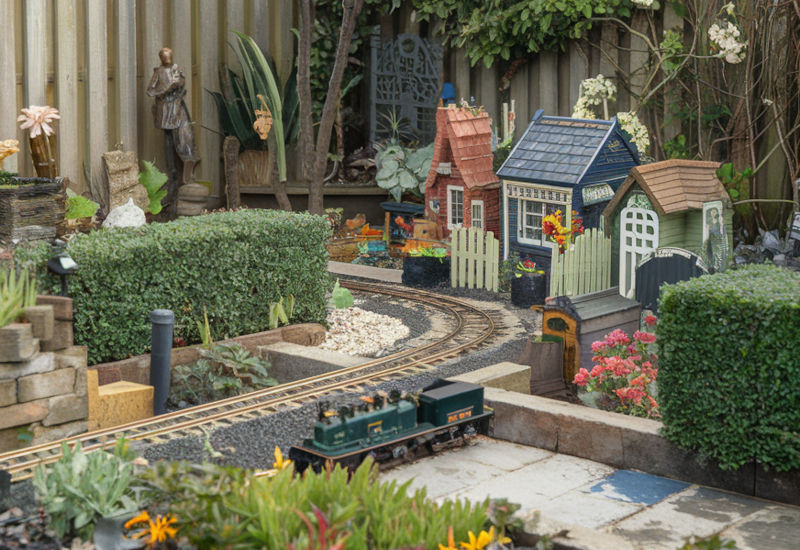
A miniature railway garden can add interest and fun to any domestic outdoor space.
Meaning in miniature gardens
Records of ancient (BCE) miniature Japanese gardens suggest they were a ritualistic recreation of a Buddhist mythological island (Sumer) which was surrounded by water [23] echoing the Vietnamese Hon Non Bo style creations described above. In ‘What Gardens Mean’, Stephanie Ross unveils research that suggests that scale miniature Chinese gardens of specifically meaningful sites had ritualistic magic at their heart, conferring power to their Taoist creators [24]. In Zen, the contemplation of scale, infinity and relativity are all concepts encapsulated in small-scale or miniature gardens [25].
Fairy gardens are all about the fairies, but what is a fairy? The term dates back to circa 1300 and meant a supernatural or legendary creature. The word itself derives from Latin and roughly translates as ‘that which speaks of fate or destiny’ [26]. From the Middle Ages onwards, the word fairy took on many a mystical and magical concepts from being evil spirits in Ireland to helpful and useful magicians in Britain. There is even some suggestion that they relate to the spirits revered and cultivated by the ancient druids, although no evidence exists that the druids used the word fairy [27][28].
Recap
The history of miniature gardening stretches back millennia in various forms. The use of scale landscaping with both plants and inert matter is the common theme. Sometimes the designs are based on natural landscapes, with more recent trends being for formal or urban style gardens. One common thread tying the origins of all of these different cultures together is the underlying theme about the spirits or energies of existence and the fabric of reality itself: something which remains mysterious and awesome today – perhaps more so in light of the most up-to-date scientific discoveries.
It is clear that miniature gardens do not need to be confined to containers and can actually be quite sizeable pieces of work, it is the consistency of the scale of what is put in place and how the plants, hard landscaping and design relate to each other, and the garden visitor, that is important.
References
[1] Bonsai Made Easy, “Grow a Chinese bonsai tree!,” 2010. [Online]. Available:
http://www.bonsaimadeeasy.com/chinesebonsaitree.html. [Accessed 11 October 2016].
[2] Wikipedia, “Bonsai,” [Online]. Available: https://en.wikipedia.org/wiki/Bonsai. [Accessed
11 10 2016].
[3] U. S. A. R. Service, The National Bonsai and Penjing Museum of the U.S. National
Arboretum, Washington: U.S. Department of Agriculture, Agricultural Research Service,
1988.
[4] S. Dreilinger, Brooklyn Botanic Garden:Indoor Bonsai, New York: Brooklyn Botanic
Garden, 2002.
[5] I. Setiawan, Agribisnis Kreatif, Jakarta: Penebar Swadayar Group, 2012.
[6] V. L. Phan and L. Buller, Mountains in the Sea: The Vietnamese Miniature Landscape
Art of Hòn Non Bộ, Portland: Timber Press, 2001.
[7] L. D. Hills, Miniature Alpine Gardening, London : Faber & Faber, 1945.
[8] W. L. Mansel, in The Satirist, London , Samuel Tipper, 1808, p. 314.
[9] L. TalairachVielmas, Fairy Tales, Natural History and Victorian Culture, Basingstoke:
Palgrave, 2014.
[10] G. R. Varner, The Mythic Forest, The Green Man and The Spirit of Nature, New York:
Algora Publishing, 2006.
[11] D. Haase, The Greenwood Encyclopedia of Folktales and Fairy Tales, Connecticut:
Greenwood Press, 2008.
[12] G. Glenny, Glenny's Illustrated Garden ForgetMeNot, London : Cassell, Peter and
Galpin, 1860, p. 26.
[13] R. Genders, Gardening in Miniature, Ammanford: Robert Hale, 1958.
[14] E. R. Heath, Miniature Rock Gardening in Troughs and Pans, London: Collingridge,
1957.
[15] C. F. Walker, Miniature Gardening, London : Collingridge, 1955.
[16] E. McDonald, Miniature Gardening, New York: Grosset and Dunlap, 1975.
[17] J. Kramer, Miniature Plants, Indoors and Out, New York: Scribner, 1971.
[18] R. A. Stein, The World in Miniature, Stanford: Stanford University Press, 1990.
[19] J. Calvo, Gardening in Miniature: Create Your Own Tiny Living World, Portland:
Timber Press, 2013.
[20] H. Farrell, Miniature Garden Grower:Terrariums and Other Tiny Gardens to Grow
Indoors and Out, Hove: Quid Publishing, 2016.
[21] “The Mini Garden Guru – Your Miniature Garden Source: ReDefining the Miniature
Garden and Creating History,” 06 07 2013. [Online]. Available:
https://minigardener.wordpress.com/2013/06/07/redefiningtheminiaturegardenand
creatinghistory/. [Accessed 12 10 2016].
[22] J. Verducci, How to Design and Build Your Garden Railroad, Waukesha: Kalmach
Books, 2006.
[23] S. Katsumata, Gleams From Japan, Abingdon: Routledge, 2013.
[24] S. Ross, What Gardens Mean, Chicago: University of Chicago Press, 2001.
[25] S. Mansfield, Japanese Stone Gardens: Origins, Meaning, Form, Tokyo: Tuttle
Publishing, 2009.
[26] D. Harper, “fairy (n.),” [Online]. Available: http://www.etymonline.com/index.php?
allowed_in_frame=0&search=fairy. [Accessed 11 10 2016].
[27] B. C. Myers and I. Bonewits, The Mysteries of Druidry, New Jersey: Career Press,
2006.
[28] N. Bown, Faeries in Nineteenth Century Art and Literature, Cambridge : Cambridge
University Press, 2001.